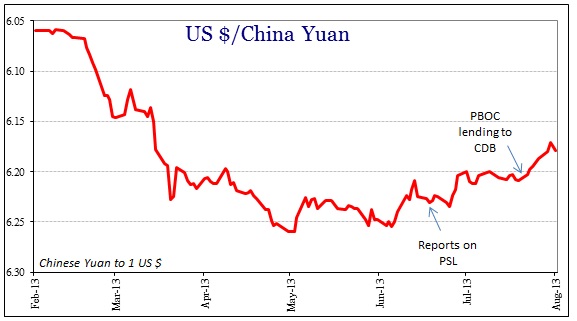Chinese financial behavior more recently has been far more favorable than the first part of the year. While there still remains this idea of PBOC control, I think, again, that the second quarter fully bears out the lack of control and the fear that engendered. Very quietly, the PBOC in June rolled out something called the “pledged supplementary lending” program. Its design was apace the latest “evolution” in central banking, following upon the blueprint offered by the ECB’s T-LTRO’s. It is not enough to engage in generic monetary “stimulus” with a flood of ledger money to banks, but rather to “target” and specifically allocate resources.
This is not isolated as I think it is being rolled out everywhere with major ramifications (though that is a topic for some other time). For China, the effect has been very much re-assuring to “market” participants.
On July 21, several media outlets in China reported that China Development Bank had received 1 trillion yuan in funding commitments under the PSL. The terms were purportedly for 3 years and less than 6% interest. The immediate use of the funds was to renovate “shanty towns”, a political purpose aligned with the recent Communist Party directives. Monetarily, the intent is to both allocate financial resources while simultaneously expressing some high degree of influence on funding rates beyond the very short-term.
It appears as if the dollar markets have been enthused by the measures. While directed internally, dollar availability increases (to finance China’s growing dollar short position based on trade externalities) as lenders assume that the PSL amounts to continued “easing.” Such an environment, so it is assumed, should lessen or at least redirect any additional default pressures. We will see if that is ultimately the case, but financial markets are obviously, again, optimistic about the prospects currently (while I remain, surprise, highly skeptical).
“This is another targeted easing measure,” Chang Jian, chief China economist at Barclays Plc, wrote in a July 30 report. While the loan doesn’t represent “broad loosening,” it has “reduced recent market concerns about a shift in the PBOC’s stance away from easing towards neutral or tightening,” she said.
There is more than a little recognition, though cloaked, of failure of the “broad loosening” approach that has dominated since September 2007. There were always recognized costs to undertaking such measures, but those were believed to be more than fully offset by the resulting growth that was expected to be generated. In other words, central banks, including the PBOC, understood the potentially dangerous nature of flooding ledger money but any such imbalance created by that would be consumed as trivial inside a thriving economy.
Now we see the downside very clearly as the thriving economy has yet to make an appearance seven years into the flood.
China may have a housing bubble only in “some cities,” a [SIC] issue that’s difficult to resolve with a single nationwide policy, the nation’s central bank Governor Zhou Xiaochuan said.
For an economy that “may” have a housing bubble to slow so dramatically cuts against everything that the orthodoxy believed about the closed system nature of economies. Yet, here the PBOC must wrestle with the very real contradiction – finding an answer to bubbles while not imperiling growth. To thread that tiny needle with such coarse thread is beyond a tall order, and I think, more than anything, the PSL represents a very real assessment of fear and doubt.
They know they can’t flood again without exacerbating both housing and consumer inflation, but at the same time the PBOC officials abhorred the results of their “experimentation” with defaults and natural corrections to imbalance at the beginning of this year. In short, they are searching for the mythical “soft landing”, and of immense proportion. Markets currently seem to be enthralled by the potential, which may not be surprising given the lack of potential pretty much everywhere else.
Click here to sign up for our free weekly e-newsletter.
“Wealth preservation and accumulation through thoughtful investing.”
For information on Alhambra Investment Partners’ money management services and global portfolio approach to capital preservation, contact us at: jhudak@4kb.d43.myftpupload.com


Stay In Touch